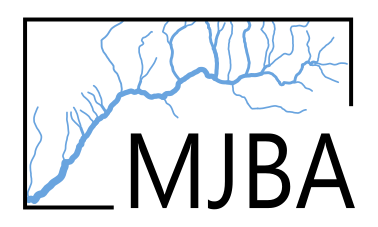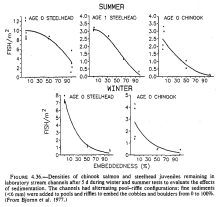Embeddedness and Chinook Fry Density (Summer)
stobias
View all records in the stressor response library
Species Common Name
Chinook Salmon
Latin Name (Genus species)
Oncorhynchus tshawytscha
Stressor Name
Sedimentation
Specific Stressor Metric
Fine Sediment
Stressor Units
% of cobbles and boulders embedded by added fine sediment
Vital Rate (Process)
Density
Life Stage
Season
Summer
Detailed SR Function Description
Densities of age 0 chinook salmon remaining in laboratory stream channels after 5 d during winter and summer tests to evaluate the effects of sedimentation. The channels had alternative pool-riffle configurations; fine sediments (<6 mm) were added to pool and riffles to embed the cobbles and boulders from 0 - 100%.
The summer or winter carrying capacity of the stream for fish declines when the fine sediments fill the interstitial spaces of the substrate.
The substrates of salmonid streams are important habitats for incubating embryos and aquatic invertebrates that provide much of the food of salmonids, and they provide cover for fish in summer and winter. Silt and sand substrates have little or no value as cover for fish. Salmonids will hide in the interstitial spaces in stream substrates, and newly emerged fry can occupy the voids of substrate made up of 2.5cm diameter rocks.
The summer or winter carrying capacity of the stream for fish declines when the fine sediments fill the interstitial spaces of the substrate.
The substrates of salmonid streams are important habitats for incubating embryos and aquatic invertebrates that provide much of the food of salmonids, and they provide cover for fish in summer and winter. Silt and sand substrates have little or no value as cover for fish. Salmonids will hide in the interstitial spaces in stream substrates, and newly emerged fry can occupy the voids of substrate made up of 2.5cm diameter rocks.
Function Derivation
laboratory experiment
Function Type
continuous
Stressor Scale
linear
References Cited
Bjornn, T. C., & Reiser, D. W. (1991). Habitat requirements of salmonids in streams. American Fisheries Society Special Publication, 19(837), 104.
Stressor Response csv data
sr_curve (14).csv
(491 bytes)
| Stressor (X) | Mean System Capacity (%) | SD | low.limit | up.limit |
|---|---|---|---|---|
| 0.00 | 2.47 | 0.00 | 2.47 | 2.47 |
| 4.30 | 2.30 | 0.00 | 2.30 | 2.30 |
| 9.68 | 2.07 | 0.00 | 2.07 | 2.07 |
| 15.05 | 1.86 | 0.00 | 1.86 | 1.86 |
| 19.00 | 1.70 | 0.00 | 1.70 | 1.70 |
| 22.94 | 1.57 | 0.00 | 1.57 | 1.57 |
| 28.32 | 1.41 | 0.00 | 1.41 | 1.41 |
| 32.97 | 1.24 | 0.00 | 1.24 | 1.24 |
| 39.43 | 1.06 | 0.00 | 1.06 | 1.06 |
| 45.88 | 0.87 | 0.00 | 0.87 | 0.87 |
| 53.05 | 0.70 | 0.00 | 0.70 | 0.70 |
| 61.29 | 0.52 | 0.00 | 0.52 | 0.52 |
| 74.19 | 0.30 | 0.00 | 0.30 | 0.30 |
| 85.30 | 0.18 | 0.00 | 0.18 | 0.18 |
| 94.98 | 0.10 | 0.00 | 0.10 | 0.10 |
| 100.00 | 0.08 | 0.00 | 0.08 | 0.08 |
Stressor Response Chart

